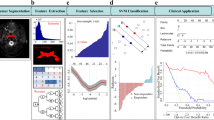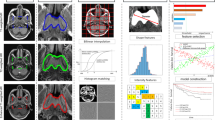Abstract
Purpose
This study aimed to discover intra-tumor heterogeneity signature and validate its predictive value for adjuvant chemotherapy (ACT) following concurrent chemoradiotherapy (CCRT) in locoregionally advanced nasopharyngeal carcinoma (LA-NPC).
Materials and methods
397 LA-NPC patients were retrospectively enrolled. Pre-treatment contrast-enhanced T1-weighted (CET1-w) MR images, clinical variables, and follow-up were retrospectively collected. We identified single predictive radiomic feature from primary gross tumor volume (GTVnp) and defined predicted subvolume by calculating voxel-wised feature mapping and within GTVnp. We independently validate predictive value of identified feature and associated predicted subvolume.
Results
Only one radiomic feature, gldm_DependenceVariance in 3 mm-sigma LoG-filtered image, was discovered as a signature. In the high-risk group determined by the signature, patients received CCRT + ACT achieved 3-year disease free survival (DFS) rate of 90% versus 57% (HR, 0.20; 95%CI, 0.05–0.94; P = 0.007) for CCRT alone. The multivariate analysis showed patients receiving CCRT + ACT had a HR of 0.21 (95%CI: 0.06–0.68, P = 0.009) for DFS compared to those receiving CCRT alone. The predictive value can also be generalized to the subvolume with multivariate HR of 0.27 (P = 0.017) for DFS.
Conclusion
The signature with its heterogeneity mapping could be a reliable and explainable ACT decision-making tool in clinical practice.





Similar content being viewed by others
Data Availability
The patients' clinical and DICOM data are not publicly available for patient privacy protection purposes. Requests to access these datasets should be directed to the corresponding author.
References
Sung H, Ferlay J, Siegel RL, Laversanne M, Soerjomataram I, Jemal A, Bray F, Global Cancer Statistics (2020) GLOBOCAN estimates of incidence and mortality worldwide for 36 cancers in 185 countries. CA: A Cancer J Clin 71(2021):209–249. https://doi.org/10.3322/caac.21660
Caudell JJ, Gillison ML, Maghami E, Spencer S, Pfister DG, Adkins D, Birkeland AC, Brizel DM, Busse PM, Cmelak AJ, Colevas AD, Eisele DW, Galloway T, Geiger JL, Haddad RI, Hicks WL Jr, Hitchcock YJ, Jimeno A, Leizman D, Mell LK, Mittal BB, Pinto HA, Rocco JW, Rodriguez CP, Savvides PS, Schwartz D, Shah JP, Sher D, St. John M, Weber RS, Weinstein G, Worden F, Yang Bruce J, Yom SS, Zhen W, Burns JL, Darlow SD, (2022) NCCN Guidelines® Insights: Head and Neck Cancers, Version 1.2022. J Nat Compr Cancer Netw 20:224–234. https://doi.org/10.6004/jnccn.2022.0016
Aerts HJWL, Velazquez ER, Leijenaar RTH, Parmar C, Grossmann P, Cavalho S, Bussink J, Monshouwer R, Haibe-Kains B, Rietveld D, Hoebers F, Rietbergen MM, Leemans CR, Dekker A, Quackenbush J, Gillies RJ, Lambin P (2014) Decoding tumour phenotype by noninvasive imaging using a quantitative radiomics approach. Nat Commun 5:4006. https://doi.org/10.1038/ncomms5006
Peng H, Dong D, Fang M-J, Li L, Tang L-L, Chen L, Li W-F, Mao Y-P, Fan W, Liu L-Z, Tian L, Lin A-H, Sun Y, Tian J, Ma J (2019) Prognostic value of deep learning PET/CT-based radiomics: potential role for future individual induction chemotherapy in advanced nasopharyngeal carcinoma. Clin Cancer Res 25:4271–4279. https://doi.org/10.1158/1078-0432.CCR-18-3065
Zhong L, Dong D, Fang X, Zhang F, Zhang N, Zhang L, Fang M, Jiang W, Liang S, Li C, Liu Y, Zhao X, Cao R, Shan H, Hu Z, Ma J, Tang L, Tian J (2021) A deep learning-based radiomic nomogram for prognosis and treatment decision in advanced nasopharyngeal carcinoma: a multicentre study. EBioMedicine. https://doi.org/10.1016/j.ebiom.2021.103522
Shen H, Yin J, Niu R, Lian Y, Huang Y, Tu C, Liu D, Wang X, Lan X, Yuan X, Zhang J (2022) MRI-based radiomics to compare the survival benefit of induction chemotherapy plus concurrent chemoradiotherapy versus concurrent chemoradiotherapy plus adjuvant chemotherapy in locoregionally advanced nasopharyngeal carcinoma: a multicenter study. Radiother Oncol 171:107–113. https://doi.org/10.1016/j.radonc.2022.04.017
Severn C, Suresh K, Görg C, Choi YS, Jain R, Ghosh D (2022) A pipeline for the implementation and visualization of explainable machine learning for medical imaging using radiomics features. Sensors 22:5205. https://doi.org/10.3390/s22145205
Ming X, Oei RW, Zhai R, Kong F, Du C, Hu C, Hu W, Zhang Z, Ying H, Wang J (2019) MRI-based radiomics signature is a quantitative prognostic biomarker for nasopharyngeal carcinoma. Sci Rep 9:10412. https://doi.org/10.1038/s41598-019-46985-0
Oba K, Paoletti X, Alberts S, Bang Y-J, Benedetti J, Bleiberg H, Catalano P, Lordick F, Michiels S, Morita S, Ohashi Y, Pignon J, Rougier P, Sasako M, Sakamoto J, Sargent D, Shitara K, Cutsem EV, Buyse M, Burzykowski T (2013) Disease-free survival as a surrogate for overall survival in adjuvant trials of gastric cancer: a meta-analysis. J Natl Cancer Inst 105:1600–1607. https://doi.org/10.1093/jnci/djt270
Chen L, Hu C-S, Chen X-Z, Hu G-Q, Cheng Z-B, Sun Y, Li W-X, Chen Y-Y, Xie F-Y, Liang S-B, Chen Y, Xu T-T, Li B, Long G-X, Wang S-Y, Zheng B-M, Guo Y, Sun Y, Mao Y-P, Tang L-L, Chen Y-M, Liu M-Z, Ma J (2017) Adjuvant chemotherapy in patients with locoregionally advanced nasopharyngeal carcinoma: Long-term results of a phase 3 multicentre randomised controlled trial. Eur J Cancer 75:150–158 (dise)
van Griethuysen JJM, Fedorov A, Parmar C, Hosny A, Aucoin N, Narayan V, Beets-Tan RGH, Fillion-Robin J-C, Pieper S, Aerts HJWL (2017) Computational radiomics system to decode the radiographic phenotype. Can Res 77:e104–e107. https://doi.org/10.1158/0008-5472.CAN-17-0339
Zwanenburg A, Vallières M, Abdalah MA, Aerts HJWL, Andrearczyk V, Apte A, Ashrafinia S, Bakas S, Beukinga RJ, Boellaard R, Bogowicz M, Boldrini L, Buvat I, Cook GJR, Davatzikos C, Depeursinge A, Desseroit M-C, Dinapoli N, Dinh CV, Echegaray S, El Naqa I, Fedorov AY, Gatta R, Gillies RJ, Goh V, Götz M, Guckenberger M, Ha SM, Hatt M, Isensee F, Lambin P, Leger S, Leijenaar RTH, Lenkowicz J, Lippert F, Losnegård A, Maier-Hein KH, Morin O, Müller H, Napel S, Nioche C, Orlhac F, Pati S, Pfaehler EAG, Rahmim A, Rao AUK, Scherer J, Siddique MM, Sijtsema NM, Socarras Fernandez J, Spezi E, Steenbakkers RJHM, Tanadini-Lang S, Thorwarth D, Troost EGC, Upadhaya T, Valentini V, van Dijk LV, van Griethuysen J, van Velden FHP, Whybra P, Richter C, Löck S (2020) The image biomarker standardization initiative: standardized quantitative radiomics for high-throughput image-based phenotyping. Radiology 295:328–338. https://doi.org/10.1148/radiol.2020191145
Zwanenburg A, Leger S, Agolli L, Pilz K, Troost EGC, Richter C, Löck S (2019) Assessing robustness of radiomic features by image perturbation. Sci Rep 9:614. https://doi.org/10.1038/s41598-018-36938-4
Teng X, Zhang J, Zwanenburg A, Sun J, Huang Y, Lam S, Zhang Y, Li B, Zhou T, Xiao H, Liu C, Li W, Han X, Ma Z, Li T, Cai J (2022) Building reliable radiomic models using image perturbation. Sci Rep 12:10035. https://doi.org/10.1038/s41598-022-14178-x
Koo TK, Li MY (2016) A guideline of selecting and reporting intraclass correlation coefficients for reliability research. J Chiropr Med 15:155–163. https://doi.org/10.1016/j.jcm.2016.02.012
Al-Sarraf M, LeBlanc M, Giri PG, Fu KK, Cooper J, Vuong T, Forastiere AA, Adams G, Sakr WA, Schuller DE, Ensley JF (1998) Chemoradiotherapy versus radiotherapy in patients with advanced nasopharyngeal cancer: phase III randomized Intergroup study 0099. J Clin Oncol 16:1310–1317. https://doi.org/10.1200/JCO.1998.16.4.1310
You R, Cao Y-S, Huang P-Y, Chen L, Yang Q, Liu Y-P, Zou X, Zhang Y-N, Jiang R, Zhang M-X, Duan C-Y, Lin A-H, Hong M-H, Chen M-Y (2017) The changing therapeutic role of chemo-radiotherapy for loco-regionally advanced nasopharyngeal carcinoma from two/three-dimensional radiotherapy to intensity-modulated radiotherapy: a network meta-analysis. Theranostics 7:4825–4835. https://doi.org/10.7150/thno.21815
Chen YP, Wang ZX, Chen L, Liu X, Tang LL, Mao YP, Li WF, Lin AH, Sun Y, Ma J (2015) A Bayesian network meta-analysis comparing concurrent chemoradiotherapy followed by adjuvant chemotherapy, concurrent chemoradiotherapy alone and radiotherapy alone in patients with locoregionally advanced nasopharyngeal carcinoma. Ann Oncol 26:205–211. https://doi.org/10.1093/annonc/mdu507
Ribassin-Majed L, Marguet S, Lee AWM, Ng WT, Ma J, Chan ATC, Huang P-Y, Zhu G, Chua DTT, Chen Y, Mai H-Q, Kwong DLW, Cheah S-L, Moon J, Tung Y, Chi K-H, Fountzilas G, Bourhis J, Pignon JP, Blanchard P (2017) What is the best treatment of locally advanced nasopharyngeal carcinoma? An individual patient data network meta-analysis. J Clin Oncol 35:498–505. https://doi.org/10.1200/JCO.2016.67.4119
Chan ATC, Hui EP, Ngan RKC, Tung SY, Cheng ACK, Ng WT, Lee VHF, Ma BBY, Cheng HC, Wong FCS, Loong HHF, Tong M, Poon DMC, Ahuja AT, King AD, Wang K, Mo F, Zee BCY, Chan KCA, Lo YMD (2018) Analysis of plasma epstein-barr virus DNA in nasopharyngeal cancer after chemoradiation to identify high-risk patients for adjuvant chemotherapy: a randomized controlled trial. J Clin Oncol. https://doi.org/10.1200/JCO.2018.77.7847
Mao Y-P, Tang L-L, Chen L, Sun Y, Qi Z-Y, Zhou G-Q, Liu L-Z, Li L, Lin A-H, Ma J (2016) Prognostic factors and failure patterns in non-metastatic nasopharyngeal carcinoma after intensity-modulated radiotherapy. Chin J Cancer 35:103. https://doi.org/10.1186/s40880-016-0167-2
Jha AK, Mithun S, Jaiswar V, Sherkhane UB, Purandare NC, Prabhash K, Rangarajan V, Dekker A, Wee L, Traverso A (2021) Repeatability and reproducibility study of radiomic features on a phantom and human cohort. Sci Rep 11:2055. https://doi.org/10.1038/s41598-021-81526-8
Sun C, Wee WG (1983) Neighboring gray level dependence matrix for texture classification. Comput Vis, Graph, Image Process 23:341–352. https://doi.org/10.1016/0734-189X(83)90032-4
Welch ML, McIntosh C, Haibe-Kains B, Milosevic MF, Wee L, Dekker A, Huang SH, Purdie TG, O’Sullivan B, Aerts HJWL, Jaffray DA (2019) Vulnerabilities of radiomic signature development: the need for safeguards. Radiother Oncol 130:2–9. https://doi.org/10.1016/j.radonc.2018.10.027
Acknowledgements
We would like to thank the radiation oncology department of Queen Elizabeth Hospital for providing valuable clinical and radiotherapy data.
Funding
This research was partly supported by research grants of Mainland-Hong Kong Joint Funding Scheme (MHKJFS) (MHP/005/20), Shenzhen-Hong Kong-Macau S&T Program (Category C) (SGDX20201103095002019), Shenzhen Basic Research Program (JCYJ20210324130209023), Project of Strategic Importance Fund (P0035421) and Projects of RISA (P0043001) from The Hong Kong Polytechnic University, and Health and Medical Research Fund (HMRF 09200576), Health Bureau, The Government of the Hong Kong Special Administrative Region.
Author information
Authors and Affiliations
Contributions
Xinzhi Teng and Jiang Zhang are both first authors of the manuscript. Xinzhi Teng and Jiang Zhang are contributed to manuscript writing and statistical analysis. Xinyang Han, Jiachen Sun, Sai-Kit Lam, Qi-Yong Hemis Ai, Zongrui Ma, Francis Kar-Ho Lee, Kwok-Hung Au, Celia Wai-Yi Yip, James Chung Hang Chow, Victor Ho-Fun Lee are contributed to data collection, data curation, and manuscript writing.
Corresponding author
Ethics declarations
Conflict of interest
The authors declare that the research was conducted in the absence of any commercial or financial relationships that could be construed as a potential conflict of interest.
Ethical approval and consent to participate
The use of data was approved by the Research Ethics Committee (Kowloon Central/Kowloon East), reference number KC/KE-18-0085/ER-1. Due to the retrospective nature of retrospective study, the consent was waived.
Additional information
Publisher's Note
Springer Nature remains neutral with regard to jurisdictional claims in published maps and institutional affiliations.
Supplementary Information
Below is the link to the electronic supplementary material.
Rights and permissions
Springer Nature or its licensor (e.g. a society or other partner) holds exclusive rights to this article under a publishing agreement with the author(s) or other rightsholder(s); author self-archiving of the accepted manuscript version of this article is solely governed by the terms of such publishing agreement and applicable law.
About this article
Cite this article
Teng, X., Zhang, J., Han, X. et al. Explainable machine learning via intra-tumoral radiomics feature mapping for patient stratification in adjuvant chemotherapy for locoregionally advanced nasopharyngeal carcinoma. Radiol med 128, 828–838 (2023). https://doi.org/10.1007/s11547-023-01650-5
Received:
Accepted:
Published:
Issue Date:
DOI: https://doi.org/10.1007/s11547-023-01650-5




